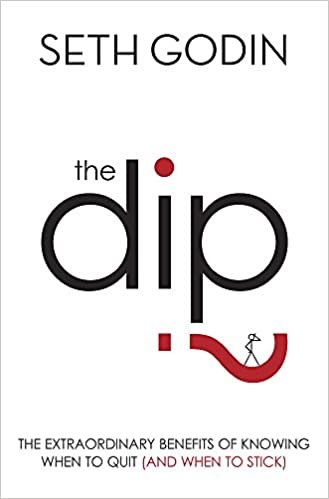
The Dip
With the help of The Dip, I came to realise that to move abstract concepts such as “fail forward” or “investor mindset” into practical advice. I needed to define and attach meaning to the concept. In doing so, I could move an abstract concept into practical advice that could impact my daily practice, routines and ultimately my behaviour.
Maybe you should quit?
The Dip asks you to consider defining the circumstances under which you are willing to quit prior to starting a project, career choice or just about anything that involves a degree of difficulty.
We often don’t quit the right stuff. Instead we:
- Continuing to hold out, committing resources with no sign of progress
- Quit when holding out for a while longer would see us overcome The Dip and become the best at what we do.
Quitting is not easy, under pressure our decision making can be unreliable. Often we choose the wrong outcome. Especially:
If pride and ego are present
If we are in love with the idea of creating something big
Or if we are forever optimistic, living in the hope of it working out
By defining the circumstances under which you are willing to quit, always, prior to taking on a task. Then you are ready to accept losses like an investor, free from emotion and unfazed. It is after all simply part of the game you play.
The Dip is the hard part of any project, the part that takes time, money and effort to pass through it. Think of The Dip as the moat, the ring-fence, a hurdle to keep out those who are not willing to push through The Dip
Make it through the Dip and longevity, exclusivity and success are your rewards.
The question is. Do you have the resources to make it through The Dip?
No. Then learn to quit. Quitting before you start could be an excellent choice.
Quitting often is a choice, making failing forward a strategy.
The opposite is a series of uncontrolled disasters with very little personal or financial growth.
Stick to your plan, failing forward with clearly defined failure criteria and you will fail forward with new skills, retained resources and the confidence that comes from making a full recovery.
So now you have learnt to quit, you don’t have the resources required to conquer the peak you initially wanted, what next?
The opposite of quitting is rededication. Find a smaller marketplace, an easier place to trade or a career that demands less of you. Claim your place, seek out the dip and find your way to becoming the best available in your world.
Your world is subjective and defined by your customer. No market is too small or too niche. It requires you to own it and continue to invest in becoming better.
Be more in love with doing the work than the big idea. Being in love with the big idea is often the root cause of failure
It is impossible to over-invest in becoming good at what you do, market leader, as your investment will only serve to increase the dip for your competition. Build a moat around your marketplace.
How The Dip may just make the dream work
Teamwork makes the dream work. Unless of course, you are the idea’s guy surrounded by risk-averse team members.
Team members can soon lose their nerve when the project is not going smoothly. Sticking points brings friction. A warning sign for some, An opportunity for others.
The room is now split and frustration in the boardroom appears quickly on both sides.
The dip brings scarcity. Scarcity brings value. Bringing value to the marketplace, your project, your career, should be your goal. The Dip and then friction it brings is precisely what we are looking for.
Get your team on board by agreeing on an exit plan based on failure criteria prior to a project starting. Tell them to expect The Dip and gain agreement on a collective will to push through.
Pitfall
When The Dip is actually a Cul De Sac or a Dead-End
A dead-end is when progress is not present and yet you push forward because it is easier and more comfortable than quitting. Quitting a cul de sac asks you to endure short-term pain.
The alternative, hope is not a strategy.
Realise you are in a cul-de-sac, endure the short term pain and switch your resources to where your efforts will produce a marked difference.
Beware of diversification
Are you diversifying because it is easier than specialising, failing to push through the dip?
Steps to take
Define your fears and define your failure criteria. Then begin your project planning as normal
Upsides include
- Managing your finite time
- Managing your resources
- Keeping hold of your dream and passion. Fail and reinvent the idea. Repurpose. No need to drop it. Keep the passion intact.
- Don’t sit on ideas, execute instead. Learn to move quickly and with acceptance by using project design criteria that include a failure element to the planning.
IT uses a term called disaster-recovery planning.
Before quitting ask yourself:
Am I panicking, scared or hurt?
Am I making measurable progress?
Don’t be afraid to quit the wrong stuff and back your conviction to stick with the right stuff.
Note to Ultra distance runners and extreme athletes:
Write down under what circumstances you are willing to quit a race before you stand on the starting line. Not during the race when you won’t be thinking straight. It is too late then.
Outline a quitting strategy and stick to it.